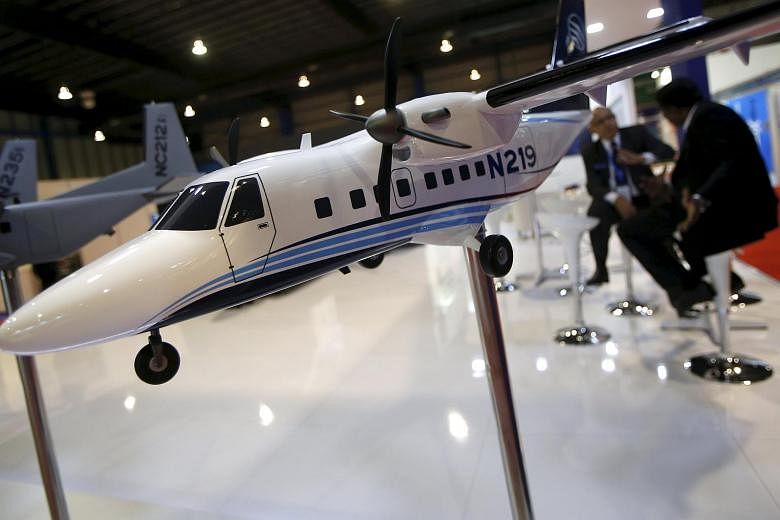SINGAPORE (REUTERS) - Indonesia is about to roll out its first passenger plane, one of several smaller, homegrown aircraft being studied in Asia, designed especially for short hops across the region's emerging markets, where air travel is booming.
State-owned aerospace firm PT Dirgantara Indonesia's 19-seat N219, which cost US$400 million (S$547.7 million) and took just over five years to make, is scheduled to make its first flight in June and start deliveries in 2018.
South Korea is mulling a 100-seat aircraft, and India has considered a 70-90 seater.
Novices in a highly competitive industry, these largely state-owned manufacturers are betting on growing passenger numbers and an increase in short flights operated by small, efficient craft. The planned craft would be smaller than the Airbus 320 or Boeing 737, which seat between about 150 and 190 passengers.
Instead, they aim to be cost-effective, nimble alternatives to planes produced by Brazil's Embraer, Canada's Bombardier, and European firm ATR, a joint venture between Airbus and Finmeccanica.
Many of these could suit some markets in Asia, South America and Africa, executives say, where demand for air travel is growing but infrastructure development often lags demand. Runways at many smaller airports are not always long enough to accommodate larger planes like the A320 and 737.
But while countries see the launch of a commercial aircraft as an important economic milestone, designing a plane from scratch is also an expensive gamble. Both China and Japan have struggled to create jets that sell.
Asian markets are a testbed for smaller aircraft.
The International Air Transport Association (IATA), which represents airlines, expects Indonesia will be one of the five fastest growing markets over the next 20 years. But the country also has many low-density cities where poor airport infrastructure has been a drag on strong demand for air travel.
Other emerging markets face a similar challenge, Mr Ade Yuyu Wahyuna, vice-president of business development and marketing at PT Dirgantara Indonesia (PTDI), told Reuters.
Powered by two turboprop engines from Pratt & Whitney, a unit of United Technologies, Indonesia's N219 is similar to the Airbus CASA CN212 that PTDI manufactured under licence in the 2000s. PTDI says it has 150 commitments from small Indonesian regional carriers.
It is just the start of the company's aerospace ambitions, said Mr Wayhuna. PTDI is also studying a 50-passenger plane.
For its part, Korea Aerospace Industries, which develops and license-produces fighter jets and helicopters, has been studying a 100-seat passenger aircraft for more than a year, said an industry executive familiar with KAI's plans.
KAI would prefer to work with established Western aerospace firms if it goes ahead, this person added.
"We will initially start with mid-sized passenger aircrafts or business jets, instead of taking on Boeing directly with large-sized jets," said a KAI spokesman, who added these remain mid to-long term plans.
Indian state-owned aerospace firm Hindustan Aeronautics (HAL) and research agency National Aerospace Laboratories (NAL) have both studied separate projects for a 70-90 seat aircraft. HAL and NAL declined to comment.
Industry executives said both are waiting for the Indian government to clarify its aerospace policy, especially on the taxation of aircraft and aircraft parts and the opening of smaller airports in secondary cities.
China and Japan's experience with homegrown craft, however, underlines the costly challenge ahead.
The MA60 turboprop, China's first passenger aircraft - developed by state-owned Aviation Industry Corp of China (AVIC) and delivered from 2000 - has been involved in 11 major incidents. This includes four in which the plane was completely written off and one that resulted in 25 deaths.
In August 2013, the New Zealand government warned tourists not to fly on a Tongan airline's MA60, citing the incidents.
Another Chinese plane, Commercial Aircraft Corp of China's long-delayed ARJ-21 regional jet, has not received US certification after seven years of testing.
In Japan, Mitsubishi Heavy Industries' MRJ regional jet has also struggled. The jet's first flight in November 2015 was more than three years behind schedule. Its first deliveries have been delayed by more than four years to mid-2018.
Embraer has since unveiled an upgraded version of its regional jets, giving it an order backlog of 513 planes across its line-up. The MRJ garnered just 233 firm orders.
Industry analysts expect Mitsubishi may only supply a quarter of the roughly 4,000 regional jets that will be needed in the 20 years to 2013. Embraer, by contrast, would control 60 per cent of the market, they say.
"We are very confident of getting a good share in this market," Mr Yugo Fukuhara, vice-president and general manager of sales and marketing for the MRJ, told Reuters.
Analysts say the newcomers should learn from the Chinese experience of putting a state-owned firm in-charge of a aircraft programmes and trying to source everything at home.
They will also need to master the complexity of a large supply chain, pass the rigorous certification process, and establish an after-sales support network.

